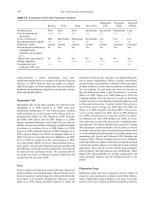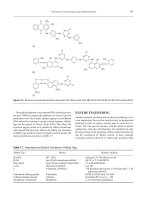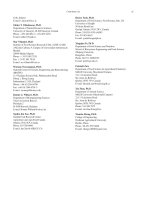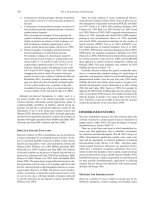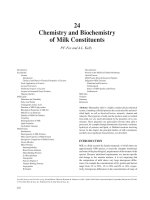8 food biochemistry and food phần 108
Bạn đang xem bản rút gọn của tài liệu. Xem và tải ngay bản đầy đủ của tài liệu tại đây (103.15 KB, 5 trang )
P1: SFK/UKS
BLBS102-c26
P2: SFK
BLBS102-Simpson
March 21, 2012
13:51
Trim: 276mm X 219mm
Printer Name: Yet to Come
26 Equid Milk: Chemistry, Biochemistry and Processing
HPLC. Annali della Facolt`a di Medicina Veterinaria, Universit`a
di Parma (Italy) 20: 143–152.
Malacarne M et al. 2002. Protein and fat composition of mare’s milk:
some nutritional remarks with reference to human and cow’s milk.
Intern Dairy J 12: 869–897.
Malkoski M et al. 2001. Kappacin, a novel antibacterial peptide from
bovine milk. Antimicrob Agents Chemother 45: 2309–2315.
Marchand S et al. 2009. Thermal inactivation kinetics of alkaline
phosphatase in equine milk. Intern Dairy J 19: 763–767.
Marconi E, Panfili G. 1998. Chemical composition and nutritional
properties of commercial products of mare milk powder. J Food
Compost Anal 11: 178–187.
Mariani P et al. 2001. Physicochemical properties, gross composition, energy value and nitrogen fractions of Halflinger nursing
mare milk throughout 6 lactation months. Anim Res 50: 415–
425.
Martin P et al. 1996. The gene encoding α s1 -casein is expressed
in human mammary epithelial cells during lactation. Lait 76:
523–535.
Martin P et al. 2011. Inter-species comparison of milk proteins:
quantitative variability and molecular diversity. In: J Fuquay et al.
(eds.) Encyclopedia of Dairy Sciences, 2nd edn. Elsevier, Oxford,
3: 821–842.
Martuzzi F, Doreau M. 2006. Mare milk composition: recent findings about protein fractions and mineral content. In: N Margilia,
W Martin-Rosset (eds.) Nutrition and Feeding of the Broodmare.
EAAP publication No.20, Wageningen Academic Publishers,
The Netherlands, pp. 65–76.
Masson PL, Heremans JF. 1971. Lactoferrin in milk from different
species. Comp Biochem Physiol 39B: 119–129.
Mat´eos A et al. 2009a. Equine α s1 -casein: Characterization of alternative splicing isoforms and determination of phosphorylation
levels. J Dairy Sci 92: 3604–3615.
Mat´eos A et al. 2009b. Two-dimensional cartography of equine βcasein variants achieved by isolation of phosphorylation isoforms
and control of the deamidation phenomenon. J Dairy Sci 92:
2389–2399.
Mather IH. 2000. A review and proposed nomenclature for major proteins of the milk fat globule membrane. J Dairy Sci 83:
203–247.
McDonald TL et al. 2001. Elevated extra hepatic expression and
secretion of mammary-associated serum amyloid A 3 (M-SAA3)
into colostrum. Vet Immunol Immunopathol 3: 203–211.
McIntosh GH. 1996. Probiotics and colon cancer prevention. Asia
Pac J Clin Nutr 5: 48–52.
McSweeney PLH, Fox PF. 2009. Advanced Dairy Chemistry, vol 3:
Lactose, Water, Salts and Minor Constituents, 3rd edn. Springer
Science, New York.
Mercier J-C et al. 1976. Comparative study of the amino acid sequences of the caseinomacropeptides from seven species. FEBS
Letters 72: 208–214.
Mercier JC. 1986. Genetic engineering applied to milk producing animals: some expectations. In: C Smith (ed.) Exploiting
New Technologies in Animal Breeding: Genetic Developments
Proceedings of a Seminar in the CEC Animal Husbandry Research Programme, Oxford University Press, Edinburgh, pp. 122–
131.
Michaelidou A, Steijns J. 2006. Nutritional and technological aspects of minor bioactive components in milk and whey: Growth
527
factors, vitamins and nucleotides. Intern Dairy J 16: 1421–
1426.
Miclo L et al. 2007. The primary structure of a low-Mr multiphosphorylated variant of β-casein in equine milk. Proteomics 7:
1327–1335.
Minkiewicz P et al. 1993. The contribution of N-acetylneuraminic
acid on the stabilization of micellar casein. Pol J Food Nutr Sci
2: 39–48.
Miranda G et al. 2004. Proteomic tools to characterize the protein
fraction of Equidae milk. Proteomics 4: 2496–2509.
Molenaar AJ et al. 1996. Elevation of lactoferrin gene expression
in developing, ductal, resting, and regressing parenchymal epithelium of the ruminant mammary gland. J Dairy Sci 79: 1198–
1208.
Montagne P et al. 1998. Microparticle-enhanced nephelometric immunoassay of lysozyme in milk and other human body fluids.
Clin Chem 44: 1610–1615.
Monti G et al. 2007. Efficacy of donkey’s milk in treating highly
problematic cow’s milk allergic children : an in vivo and in vitro
study. Pediatr Allergy Immunol 18: 258–264.
Moore SA et al. 1997. Three dimensional structure of diferric bovine
lactoferrin at 2.8 Å resolution. J Mol Biol 274: 222–236.
Morozova-Roche L. 2007. Equine lysozyme: the molecular basis of
folding, self-assembly and innate amyloid toxicity. FEBS Letters
581: 2587–2592.
Nakamura T et al. 2001. Occurrence of an unusual phosphorylated
N-acetyllactosamine in horse colostrum. Biochimi et Biophy Acta
1525: 13–18.
Nakazawa T, Hosono A. 1992. Functions of Fermented Milk:
Challenges for the Health Sciences. Elsevier Applied Science,
London.
Nakhasi HL et al. 1984. Expression of κ-casein in normal and
neoplastic rat mammary gland is under the control of prolactin.
J Biol Chem 259: 14894–14898.
Natale M et al. 2004. Cow’s milk allergens identification by twodimensional immunoblotting and mass spectrometry. Mol Nutr
Food Res 48: 363–369.
Neseni R et al. 1958. Milchleistung und Milchzusammenstzung
von Studen im Verlauf der Laktation. Archiv fur Tierzucht 1:
191–129.
Neville MC. 2009. Introduction: alpha-lactalbumin, a multifunctional protein that specifies lactose synthesis in the Golgi. J Mammary Gland Biol Neoplasia 14: 211–212.
Nitta K et al. 1987. The calcium-binding properties of equine
lysozyme. FEBS Letters 223: 405–408.
Nonaka Y et al. 2008. Spontaneous asparaginyl deamidation of
canine milk lysozyme under mild conditions. Proteins 72: 313–
322.
O’Connell JE, Fox PF. 2003. Heat-induced coagulation of milk. In:
PF Fox, PLH McSweeney (eds.) Advanced Dairy Chemistry, vol.
1: Proteins, 3rd edn. Kluwer Academic/Plenum Publishers, New
York, pp. 879–945.
Ochirkhuyag B et al. 2000. Characterization of mare caseins. Identification of α s1 - and α s2 -caseins. Lait 80: 223–235.
Oftedal OT et al. 1983. Lactation in the horse: milk composition
and intake by foals. J Nutr 113: 2096–2106.
Oftedal OT, Iverson SJ. 1995. Comparative analysis of non-human
milks. In: RG Jensen (ed.) Handbook of milk composition. Academic Press, California, pp. 749–827.
P1: SFK/UKS
BLBS102-c26
P2: SFK
BLBS102-Simpson
528
March 21, 2012
13:51
Trim: 276mm X 219mm
Printer Name: Yet to Come
Part 4: Milk
Ono T et al. 1989. Subunit components of casein micelles from
bovine, ovine, caprine and equine milk. J Dairy Res 56: 61–68.
Outram AK. 2009. The earliest horse harnessing and milking. Science 323: 1332–1335.
Pagliarini E et al. 1993. Chemical and physical characteristics of
mare’s milk. Ital J Food Sci 4: 323–332.
Palmquist DL. 2006. Milk fat: origin of fatty acids and influence of
nutritional factors thereon. In: PF Fox, PLH McSweeney (eds.)
Advanced Dairy Chemistry, vol 2: Lipids, 3rd edn. Springer, New
York, pp. 43–92.
Park YW et al. 2006. Mare milk. In: YW Park, FW Haenlein (eds.)
Handbook of Non-bovine Mammals. Blackwell Publishing, Oxford, pp. 275–296.
Parodi PW. 1982. Positional distribution of fatty acids in triglycerides from milk of several species of mammals. Lipids 17:
437–442.
Patton S. 1999. Some practical implications of the milk mucins. J
Dairy Sci 82: 1115–1117.
Paulson M, Dejmek P. 1990. Thermal denaturation of whey proteins in mixtures with caseins studied by differential scanning
calorimetry. J Dairy Sci 73: 590–600.
Pelizzola V et al. 2006. Chemical-physical characteristics and fatty
acid composition of mare’s milk. Milchwissenschaft 61: 33–
36.
P´erez MD, Calvo M. 1995. Interaction of β-lactoglobulin with
retinol and fatty acids and its role as a possible biological function
for this protein: A review. J Dairy Sci 78: 978–988.
P´erez MD et al. 1993. Comparison of the ability to bind ligands
of β-lactoglobulin and serum albumin from ruminant and nonruminant species. J Dairy Res 60: 55–63.
Phadungath C. 2005. Casein micelle structure: a concise review.
Songklanakarin J Sci Technol 27: 201–212.
Phelan M et al. 2009. Casein-derived bioactive peptides: Biological
effects, industrial uses, safety aspects and regulatory status. Intern
Dairy J 19: 643–654.
Piccione G et al. 2008. Daily rhythmicity in nutrient content of
asinine milk. Livestock Sci 116: 323–327.
Pieszka M, Kulisa M. 2005. Magnesium content in mares’ milk
and growth parameters of their foals. J Elementology 10: 985–
990.
Pikul J, W´ojtowski J. 2008. Fat and cholesterol content and fatty acid
composition of mares’ colostrums and milk during five lactation
months. Livestock Sci 113: 285–290.
Pisano A et al. 1994. Characterization of O-linked glycosylation
motifs in the glycopeptide domain of bovine κ-casein. Glycobiology 4: 837–844.
Plowman JE et al. 1999. Structural features of a peptide corresponding to human κ-casein residues 84–101 by 1H-nuclear magnetic
resonance spectroscopy. J Dairy Res 66: 53–63.
Qi PX. 2007. Studies of casein micelle structure: the past and the
present. Lait 87: 363–383.
Rainhard P. 1986. Bacteriostatic activity of bovine milk lactoferrin
against mastitic bacteria. Veter Microbiol 11: 387–392.
Ramos JJ et al. 1994. Vitamin B12 levels in ewe colostrum and milk
and in lamb serum. Vet Res 25: 405–409.
Rasmussen LK et al. 1995. Human α s1 -casein: purification and
characterization. Comp Biochem PhysiolB 111: 75–81.
Rassin DK et al. 1978. Taurine and other free amino acids in milk
of man and other mammals. Early Hum Dev 2/1: 1–13.
Restani P et al. 1995. Evaluation by SDS-PAGE and immunoblotting
of residual antigenicity in hydrolysed protein formulas. Clin Exp
Allergy 25: 651–658.
Recio I et al. 2009. Bioactive components in sheep milk. In: Y.W.
Park (ed.), Bioactive Components in Milk and Dairy Products.
Wiley-Blackwell Publishers. Ames, IA, pp. 83–104.
Restani P et al. 2002. Cross-reactivity between mammalian proteins.
Ann Allergy Asthma Immunol 89: 11–15.
Rudloff S, Kunz C. 1997. Protein and nonprotein nitrogen components in human milk, bovine milk, and infant formula: Quantitative and qualitative aspects in infant nutrition. J Pediatr Gastroenterol Nutr 26: 328–344.
Saito T, Itoh T. 1992. Variations and distributions of
O-glycosidically linked sugar chains in bovine κ-casein. J Dairy
Sci 75: 1768–1774.
Salimei E. 2011. Animals that produce dairy foods: Donkey. In: W.
Fuquay et al. (eds.) Encyclopedia of Dairy Sciences, vol 1, 2nd
edn. Elsevier. Oxford, pp. 365–373.
Salimei E et al. 2002. Major constituents leptin, and non-protein
nitrogen compounds in mares’ colostum and milk. Reprod Nutr
Dev 42: 65–72.
Salimei E et al. 2004. Composition and characteristics of ass’ milk.
Anim Res 53: 67–78.
Sarwar G et al. 1998. Free amino acids in milk of human subjects,
other primates and non-primates. Brit J Nutr 79: 129–131.
Savage RJG, Long MR. 1986. Mammalian Evolution: an Illustrated
Guide. Natural History Museum, London.
Savalle B et al. 1988. Modelization of gastric digestion of milk proteins. In: CA Barth, E Schlimme (eds.) Milk Proteins. Nutritional,
Clinical, Functional and Technological Aspects. Steinkopff Publishers, Darmstad, pp. 143–149.
Savilahti E, Kuitunen M. 1992. Allergenicity of cow milk proteins.
J Pediatr 121: S12–S20.
Sawyer L. 2003. β-Lactoglobulin. In: PF Fox, PLH McSweeney
(eds.) Advanced Dairy Chemistry, vol. 1: Proteins, 3rd edn.
Kluwer Academic/Plenum Publishers, New York, pp. 319–
386.
Schaafsma G. 2003. Nutritional significance of lactose and lactose
derivatives. In: H Roginski, JW Fuquay, PF Fox (eds.) Encyclopedia of Dairy Science. Academic Press, London, pp. 1529–
1533.
Schmidt DG et al. 1995. Raising the pH of the pepsin-catalyzed
hydrolysis of bovine whey proteins increases the antigenicity of
the hydrolysates. Clin Exp Allergy 25: 1007–1017.
Schryver HF et al. 1986. Lactation in the horse: the mineral composition of mare milk. J Nutr 116: 2142–2147.
Sellnow L. 2006. Food Factory. Article 10, Equine Anatomy and
Physiology. Available at />anatomy10.pdf. Accessed on October 3, 2010.
S´elo I et al. 1999. Allergy to bovine β-lactoglobulin: specificity
of human IgE to tryptic peptides. Clin Exp Allergy 29: 1055–
1063.
Shah NP. 2000. Effects of milk-derived bioactives: an overview.
Brit J Nutr 84: S3–S10.
Shekar CP et al. 2006. κ-Casein-deficient mice fail to lactate. Proc
Natl Acad Sci U S A 103: 8000–8005.
Shimazaki KI et al. 1994. Comparative study of the iron-binding
strengths of equine, bovine and human lactoferrins. J Dairy Res
61: 563–566.
P1: SFK/UKS
BLBS102-c26
P2: SFK
BLBS102-Simpson
March 21, 2012
13:51
Trim: 276mm X 219mm
Printer Name: Yet to Come
26 Equid Milk: Chemistry, Biochemistry and Processing
Silva SV, Malcata FX. 2005. Caseins as source of bioactive peptides.
Intern Dairy J 15: 1–15.
Simopoulos AP. 2002. The importance of the ratio of omega6/omega-3 essential fatty acids. Biomedical Pharmacotherapy
56: 365–379.
Singh H et al. 1997. Physico-chemical properties of milk. In: PF
Fox (ed.) Advanced Dairy Chemistry vol. 3: Lactose, Water, Salts
and Vitamins, 2nd edn. Chapman and Hall, London, pp. 469–518.
Smith MC, Sherman DM. 2009. Goat Medicine, 2nd edn. WileyBlackwell, New York.
Smolders EAA et al. 1990. Composition of horse milk during the
suckling period. Livest Prod Sci 25: 163–171.
Sneddon JC, Argenzio RA. 1998. Feeding strategy and water homeostasis in equids: the role of the hind-gut. J Arid Envir 38:
493–509.
Sneddon JC et al. 2006. Mucosal surface area and fermentation
activity in the hind gut of hydrated and chronically dehydrated
working donkeys. J Anim Sci 84: 119–124.
Solaroli G et al. 1993. Composition and nutritional quality of mare’s
milk. Ital J Food Sci 5: 3–10.
Sood SM, Slattery CW. 2000. Association of the quadruply phosphorylated β-casein from human milk with the nonphosphorylated form. J Dairy Sci 83: 2766–2770.
Sørensen ES et al. 2003. The phosphorylation pattern of human
α s1 -casein is markedly different from the ruminant species. Eur
J Biochem 270: 3651–3655.
Souci SW et al. 2000. Food Composition and Nutrition Tables, 6th
edn. Medpharm Scientific Publishers, Stuttgart.
Spencer A et al. 1999. Expression, purification, and characterization
of the recombinant calcium-binding equine lysozyme secreted by
the filamentous fungus Aspergillus niger: comparisons with the
production of hen and human lysozymes. Protein Expression and
Purification 16: 171–180.
Spitzauer S. 1999. Allergy to mammalian proteins: at the borderline between foreign and self? Int Arch Allergy Immunol 120:
259–269.
Stasiuk SX et al. 2000. Cloning of a marsupial kappa-casein cDNA
from the brushtail possum (Trichosurus vulpecula). Reprod Fertil
Dev 12: 215–222.
Stoyanova LG et al. 1988. Freeze-dried mares’ milk and its potential use in infant and dietetic food products. Voprosy Pitaniia 2:
6467.
Străomqvist M et al. 1995. Human milk β-casein and inhibition of
Helicobacter pylori adhesion to human gastric mucosa. J Pediatr
Gastroenterol Nutr. 21: 288–296.
Stuart CA et al. 1984. Passage of cows’ milk protein in breast milk.
Clin Allergy 14: 533–535.
Surono IS, Hosono A. 2002. Fermented milks: Types and standards
of identity. In: H Roginski, JA Fuquay, PF Fox (eds.) Encyclopedia of Dairy Sciences. Academic Press, London, UK, pp.
1018–1069.
Swaisgood HF. 2003. Chemistry of caseins. In: PF Fox, PLH
McSweeney (eds.) Advanced Dairy Chemistry, vol 1: Proteins, 3rd edn. Kluwer Academic/Plenum Publishers, New York,
pp. 139–202.
Tada M et al. (2002). Stabilization of protein by replacement
of a fluctuating loop: Structural analysis of a chimera of
bovine α-lactalbumin and equine lysozyme. Biochem 41: 13807–
13813.
529
Tamine AY, Marshall VME. 1984. Microbiology and technology
of fermented milk. In: FL Davies, BA Law (eds.) Advances in
the Microbiology and Biochemistry of Cheese and Fermented
Milk. Elsevier Applied Science Publishers, London, pp. 118–
122.
Tamine AY, Robinson RK. 1999. Yoghurt: Science and Technology.
Woodhead Publishing Ltd., Cambridge.
Taylor SL. 1986. Immunologic and allergic properties of cows milk
proteins in humans. J Food Prot 49: 239250.
Thomăa-Worringer C et al. 2006. Health effects and technological features of caseinomacropeptide. Intern Dairy J 16: 1324–
1333.
Trujillo JM et al. 1962. Chromosomes of the horse, the donkey, and
the mule. Chromosoma 13: 243–248.
Tsioulpas A et al. 2007. Changes in physical properties of bovine
milk from the colostrum period to early lactation. J Dairy Sci 90:
5012–5017.
Tsuge H et al. 1992. Crystallographic studies on a calcium-binding
lysozyme from equine milk at 2.5 Å resolution. J Biochem 111:
141–143.
Turner AW. 1945. Digestibility of milk as affected by various types
of treatment. Food Res Inter 10: 52–59.
Ullrey DE et al. 1966. Composition of mare’s milk. J Anim Sci 25:
217–222.
Ullrey DE et al. 1974. Iron, zinc and copper in mare’s milk. J Anim
Sci 38: 1276–1277.
Uniacke-Lowe T. 2011. Studies on equine milk and comparative
studies on equine and bovine milk systems. PhD Thesis. The
National University of Ireland, Cork.
Uniacke T, Fox PF. 2011. Equid milk. In: J Fuquay et al. (eds.).
Encyclopedia of Dairy Sciences, vol 3, 2nd edn. Elsevier, Oxford,
pp. 518–529.
Uniacke T et al. 2010. Equine milk proteins: Chemistry, structure
and nutritional significance. Intern Dairy J 20: 609–629.
Urashima T et al. 1989. Structural determination of three neutral
oligosaccharides obtained from horse colostrum. Carbohydr Res
194: 280–287.
Urashima T et al. 2001. Oligosaccharides of milk and colostrum in
non-human mammals. Glycoconj J 18: 357–371.
Urashima T et al. 2009. Milk oligosaccharides. In: PLH McSweeney, PF Fox (eds.) Advanced Dairy Chemistry, vol. 3: Lactose, Water, Salts and Minor Constituents, 3rd edn. Springer,
London, pp. 295–349.
Van Hooydonk ACM et al. 1984. Kinetics of the chymosin-catalysed
proteolysis of κ-casein in milk. Neth Milk Dairy J 38: 207–
222.
Vesa TH et al. 2000. Lactose intolerance. J Am Coll Nutr 19:
165S–175S.
Vil`a C et al. 2001. Widespread origins of domestic horse lineages.
Science 291: 474–477.
Vincenzetti S et al. 2008. Donkey’s milk protein fractions characterization. Food Chem 106: 640–649.
Visser S et al. 1982. Isolation and characterization of β- and
γ -caseins in horse milk. Biochem J 203: 131–139.
Vreeman HJ et al. 1986. Characterization of bovine κ-casein fractions and the kinetics of chymosin-induced macropeptide release
from carbohydrate-free and carbohydrate-containing fractions
determined by high-performance gel-permeation chromatography. Biochem J 240: 87–97.
P1: SFK/UKS
BLBS102-c26
P2: SFK
BLBS102-Simpson
530
March 21, 2012
13:51
Trim: 276mm X 219mm
Printer Name: Yet to Come
Part 4: Milk
Waelchli RO et al. 1990. Relationships of total protein, specific
gravity, viscosity, refractive index and latex agglutination to immunoglobulin G concentration in mare colostrum. Equine Vet J
22: 39–42.
Wal J-M. 2002. Cow’s milk proteins/allergens. Ann Allergy Asthma
Immunol 89: 3–10.
Wal J-M. 2004. Bovine milk allergenicity. Ann Allergy Asthma
Immunol 93: S2–S11.
Walstra P. 1990. On the stability of casein micelles. J Dairy Sci 73:
1965–1979.
Walstra P, Jenness R. 1984. Dairy Chemistry and Physics. John
Wiley & Sons, New York.
Walstra P et al. 2006a. Dairy Science and Technology. CRC Press,
Boca Raton, FL.
Walstra P et al. 2006b. Dairy Technology:Principles of Milk Properties and Processes. CRC/Taylor Francis, New York.
Welsch U et al. 1988. Structural, histochemical and biochemical
observations on horse milk-fat-globule membranes and casein
micelles. Histochemistry 88: 357–365.
Whigham LD et al. 2000. Conjugated linoleic acid: implications for
human health. Pharmacol Res 42: 503–510.
Widdowson EM. 1984. Lactation and feeding patterns in different
species. In: DLM Freed (ed.) Health Hazards of Milk. Bailli`ere
Tindall, London, pp. 85–90.
Winter P et al. 2006. The potential of measuring serum amyloid
A in individual ewe milk and in farm bulk milk for monitoring udder health on sheep dairy farms. Res Vet Sci 81: 321–
326.
Wong NP et al. (eds.) 1988. Fundamentals of Dairy Chemistry, 3rd
edn. Van Nostrand Reinhold, New York.
Yongfa W et al. 1984. Prevalence of primary adult lactose malabsorption in three populations of northern China. Human Genetics
67: 103–106.
Yoshikawa M et al. 1982. Chemical characteristics of bovine casein
micelles fractionated by size on CPG-10/3000 chromatography.
Agri Biol Chem 46: 1043–1048.
Zbikowska A et al. 1992. The influence of casein micelle size on
selected functional properties of bulk milk proteins. Polish J Food
Nutr Sci 1: 2332.
Zicker SC, Lăonnerdal B. 1994. Protein and nitrogen composition
of equine (Equus caballus) milk during early lactation. Comp
Biochem Physiol 108A: 411–421.
P1: SFK/UKS
BLBS102-c27
P2: SFK
BLBS102-Simpson
March 21, 2012
13:25
Trim: 276mm X 219mm
Printer Name: Yet to Come
Part 5
Fruits, Vegetables, and Cereals
531

